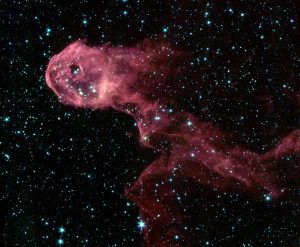At first, the night sky seems a jumble of stars. But after a while, you’ll start to see patterns and shapes, referred to as “Constellations” or “Asterisms”. Long ago, people gave names to these shapes.
Belgian astronomer Eugène Delporte (1882-1955) determined the boundaries of the 88 constellations in the sky, reporting his work in 1930. The International Astronomical Union (IAU) quickly adopted Delporte’s constellation boundaries, and they are now as familiar to us as the periodic table.
The constellations are named in Latin, many after animals, such as Draco (dragon), Leo (lion), Lupus (wolf), and Serpens (snake), and some after mythological figures, such as Hercules. Well known constellations include Andromeda, Boötes, Cepheus, Crux (the Southern Cross), Hydra, Orion, Pegasus, Ursa Major (the Great Bear).

Image credit: NASA/JPL-Caltech/W. Reach (SSC/Caltech)
They also include the even more familiar signs of the Zodiac (all 13 of them), such as Aquarius, Gemini, and Sagittarius. The 13th, by the way, is Ophiuchus.
These recognisable shapes occupy irregular areas and contain far more stars than those that make up the specific constellation, as discovered, thanks to the power of modern telescopes. Astronomers now apply the name of the constellation to the area rather than to the figure itself.
Asterisms
Asterisms should not be confused with constellations. They refer to any group of stars forming a perceived pattern, but which are not a constellation—though they may be part of a given constellation. For example, the asterism, the Plough, is part of the constellation Ursa Major; Sickle is in the constellation Leo; the Northern Cross is in Cygnus; and the Lozenge is in Draco; while Sagittarius has a Teapot! The Plough is also called the Big Dipper. There are around 30 or so well-known asterisms including the oddly named Job’s Coffin. Asterisms can also span more than one constellation.

Image credit: Nasa, ESA and AURA, by Astronomers using the Nasa Hubble Space Telescope.
The Summer Triangle stretches across the constellations Cygnus, Lyra and Aquila. The “Square of Pegasus” lies mainly in the constellation of Pegasus, but also strays into the constellation Andromeda. “Orion’s belt” is a recognisable shape (an asterism) that is part of the constellation of Orion. Finally, another example is Pleiades, which is a cluster within Taurus.
The accompanying table gives a list of some of the more notable asterisms.
Notable Asterisms – Visible to the naked eye
The Butterfly
The Circlet
The False Cross
The Fish Hook
The Great Diamond
Job’s Coffin
The Keystone
The Kite
The Lightning Bolt
The Lozenge
The Northern Cross
The Plough
The Pointers
The Saucepan
The Sickle
The Southern Cross
The Southern Pointers
The Summer Triangle
The Teapot
The Terebellum
The Winter Hexagon
The Winter Triangle
Back to Top
By Nigel Benetton, science fiction author of Red Moon Burning and The Wild Sands of Rotar.
Last updated: Thursday, 25th February 2021